|

Mysterious
concretions in Paleozoic layers on the Northern
Plateau
of Jebel Uweinat (Sudanese part)
Norbert Brügge,
Germany
Dipl.-Geol.
Update: 23.03.2020
During the trekking-tour in March 2019
to the Northern Plateau of the Jebel Uweinat, Andras Zboray and his group
discovered unusual spherical concretions in exposed layers of Paleozoic sandstone.
Location: 21°57'43.2"N / 25°00'55.9"E. The following photos were sent me by
the participants Max Damberger, Gabor Merkl and Clemens Scheidhammer.
There is a striking resemblance to special "cannonballs" in sandstones
from Utah (eg
Molen Reef, Emery county). The
formation of these structures is declared to be
epigenetic. Despite some
theories, the mechanism for the emergence of such concretions is not really
clarified.
It would therefore be of great interest to determine the detailed mineral
components of the concretions and their coating before the obviously complicated
mechanical and chemical processes are involved in the formation of this structures
can be understood.
Therefore, only an optical inventory can be presented at the moment.
This includes the very qualified observations by Andras Zboray: "The concretions
appear to form around a central nodule.
A test with dilute warm HCl was negative."
The location can be described as a cavant in the Paleozoic sandstone,
on the inner wall and bottom of which a pack of concretions can be seen, encased
by an apparently pure (?) sandy, laminated fine cement. These laminated coatings
in the pool can include several of concretions.
It can be clearly seen that there is a broken edge (pic 7) between the Paleozoic
sandstone and the brighter (?) material in the pool. This can be an indication
of the younger formation of this layer-breaking deposit, including its filling.
The possible continuation of the structure in depth cannot be determined.
Of importance for the genesis of the
deposit is its place on one of several tectonic faults on the plateau. That
could speak for post-volcanic influencing (Map-1).
An astonishing accumulation of weathered concretions (pic 15),
far from the Northern Plateau, on a plain between Karkur Murr and
Karkur Talh, and debris from the upper branch of Karkur Talh (pic 9,
11, 12/13, 14) lead to the assumption that occur more such places with
concretions in the Jebel Uweinat.
Due to the appearance, it could be assume a variable age of the cocretions
in the entire Uweinat. Some may have been formed in the Tertiary (tectonic
movements in the area). The pool on the plateau could be younger (maybe late
Quaternary, and post-volcanic influenced ?)
Particularly revealing debris come from the upper branch of Karkur
Talh (Map-2):
-
Cutted concretion reveal inside bright
inclusions of still unknown material & cutted concretions to
be infiltrated with iron solutions. Location 21°57'34.76"N / 25°02'9.74"E
(pic 9)
-
Cutted concretions reveal a dark,
still unknown material inside. Location 21°57'12.4"N / 25°01'45.2"E (pic
11)
-
Cross sections of large concretions
with radial traces that formed between a small nucleus and periphery. Location:
21°57'03.4"N / 25°01'3.5"E (pic 12, 13)
-
A remain of a mysterious sandy solution-flow.
Location: 21°57'13.42"N / 25°01'37.8"E (pic 14)
|


|
|
|
|
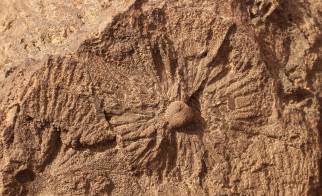
12a. Cross sections of large concretions
with radial tracks
that formed between a small nucleus and periphery
|
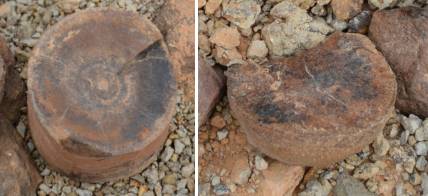
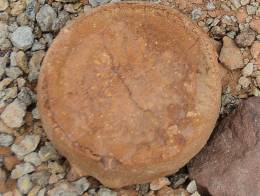
9a.
This cutted concretions to be infiltrated
with iron solutions
9b.This
cutted concretion reveal inside bright inclusions of still unknown material
|
|
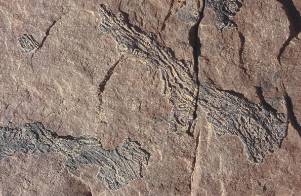
14a. A remain of sandy solution-flow
|

11a.
This cutted concretions reveal inside a dark
of still unknown material
|
|
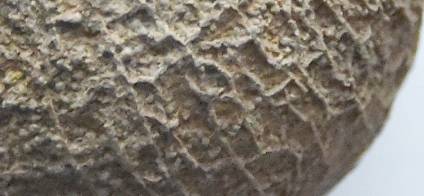
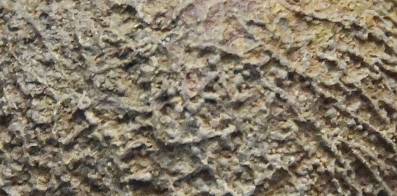
10a. The enlargement of the bullet
surface shows puzzling details regarding structure and composition
|
A look at the inner structure of the find with the radial tracks reveals
astonishing things:
- The arrangement of the grains within the radial and raised tracks
is ordered and sometimes looks like a pigtail (pic 12b, 13c).
- It cannot be confirmed that the overall grains is a typical
accumulation of exclusively rounded grains of sand.
- At some places, veins are visible that have been filled with
solutions.(pic 12c)
- There are areas in which the groundmass contains darker colored
parts. (pic 12d, 12e, 13b).
- An elongated nodule has a concentric filling (pic 13a)
|
 12b
12b
|
 12c
12c
|
 12d
12d
|
 12e
12e
|
 13a
13a
|
 13b
13b
|
 13c
13c
|
|
|
|